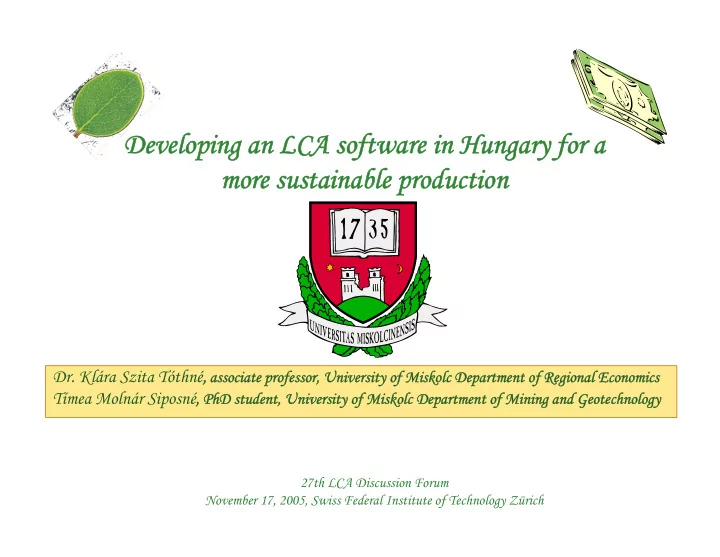

Developing an LCA software in Hungary for a Developing an LCA software in Hungary for a more sustainable production more sustainable production Dr. Klára Szita Tóthné, associate associate professor, University rofessor, University of of Misk Miskolc Department olc Department of Regional egional Economics conomics Tímea Molnár Siposné, PhD PhD student, University student, University of Miskolc Department iskolc Department of of Mining Mining and nd Geotechnology Geotechnology 27th LCA Discussion Forum November 17, 2005, Swiss Federal Institute of Technology Zürich
Developing an LCA software in Hungary Developing an LCA software in Hungary for a more sustainable production for a more sustainable production SOME WORDS ABOUT PREMISES… � In Hungary LCA application in children shoes � Softwares developed in other countries could appoint false results
Developing an LCA software in Hungary Developing an LCA software in Hungary for a more sustainable production for a more sustainable production � „Development of a national LCA database for supporting environmentally sound development of Hungarian enterprises” � Bay Zoltán Foundation for Applied Research � University of Miskolc � Economic Competitiveness Operative Program (GVOP) � Finance of the project: � 75% EU, � 25% Hungarian government
Developing an LCA software in Hungary Developing an LCA software in Hungary for a more sustainable production for a more sustainable production � Keynote: � Results in international research (SimaPro, GaBi) � Consideration of Hungarian conditions � Objectives � On-line database � Focusing to � Waste management � Energy sector � normalisation data ??? � To use in education and research
Developing an LCA software in Hungary Developing an LCA software in Hungary for a more sustainable production for a more sustainable production TARGET AUDENCE � Environmental conscious customer � Environmental conscious producer INDUSTRIAL ACTIVITIES SUSTAI NABLE DEVELOPMENT ENVIRONMENTAL PROTECTION
Developing an LCA software in Hungary Developing an LCA software in Hungary for a more sustainable production for a more sustainable production PROCEDURE OF THE RESEARCH Transportation � Estimating domestic energy-sector � � Road transport Data collection � � Railway Determining system boundaries � � Air Function of production system � � Waterway Life cycle inventory � � Hydraulic Transport kilometre, materials
Developing an LCA software in Hungary Developing an LCA software in Hungary for a more sustainable production for a more sustainable production CLASSIFICATION OF HUNGARIAN POWER PLANTS: Nuclear Power Plants � Coal – fired power plants � Natural gas- and oil fired power stations � Natural gas burning power plants (peak-load plants) � Wind energy power plants � Incinerators � Biomass burning power plants �
NUCLEAR POWER PLANT PAKS Input: Input: Total capacity: 1729 MW 1729 MW Fuel Fuel elements elements � Paricipation from Hungarian electricity production: 39, 39,1 % % Adsorbent rod Adsorben od � Saline solutions Saline solutions for or regeneration regeneration of of Hungarian Hungarian electricity lectricity production roduction � ion –exchange resins ion –exchange esins Condenser water Condenser ater � Chemicals, greasing Chemicals, greasing materials materials � Output: Output: Electricity, heat Electricity, heat � Nuclear was Nuclea astes tes � Condenser water Condenser ater � Spent oils Spent ils � Noise Noise and vibration nd vibration �
Paks PWR Radionuclide -1 év -1 ] -1 év -1 ] [GBqGW e [GBqGW e 2003 1995-1997 Emissions to air Total aerosol 4,4 x 10 0 1,3 x 10 -1 131 Iodine equivalence 2,6 x 10 2 1,7 x 10 -1 Total inert gas 3,1 x 10 5 1,3 x 10 4 Total tritium 5,0 x 10 3 2,4 x 10 3 Total radiocarbon 4,3 x 10 2 2,2 x 10 2 *** Fluent emissions Corrosive and 5,8 x 10 -1 8,1 x 10 0 cleavageproduct Tritium 1,0 x 10 4 1,9 x 10 4 Source: UNSCEAR Report, 2000
COAL BURNING POWER PLANTS Input: Input: Output: Output: � Fu Fuel el : black : black coal, brown oal, brown coal, lign oal, lignite te Slag Slag � � Industrial Industrial water water Dust-ash Dust-ash � � Lime Lime Gypsum Gypsum � � Ammonia Ammonia or methane ethane Used up ion-exchange Used ion-exchange � resin resin � Electric Electric energy nergy heat heat � � Subsituation Subsituation of the he used used up up ion ion exchange resin exchange resin � lubricants lubricants
� Natural Natural gas as firing firing: peak – load plant Input: water, oil Input: � Hydroelectric Hydroelectric power ower stations stations (hidroaccumualtion plants, hidroaccumlationless plants) Output: Output: water, slop oil, (methane) � Incinerator Incinerator � Biomass Biomass burning urning plants plants � Silvicultural Silvicultural and wood nd woodworking working waste aste � Secondary Secondary products roducts and wastes nd wastes of of traditional traditional agricultural gricultural corps corps � Cultivated Cultivated plants plants with with the the aim im of of energetic energetic � Secondary Secondary biomass iomass � biogas biogas
Avoided emissions Produced Capacity Wind power plants Date of commissioning electricity (kW) CO 2 NO X SO X (kWh) (t) (kg) (kg) Inota power plant 250 2000 1013840 983,4 740 1500 Kulcs power plant 600 2001 3858456 3693 2779 5635 1894720 Monosszolnoki ( hours run :12494) 2x600 2002.12.20-2004.12.31. 3693 2779 5635 power plant 1912730 (hours run :12312) 1448234 (hours run :10629) Mosonmagyaróvári 2x600 2003.07.01-2004..12.3 2817 2120 4299 power plant 1456215 (hours run: 10699)
Developing an LCA software in Hungary Developing an LCA software in Hungary for a more sustainable production for a more sustainable production NEXT STEPS � Parameters and trends of Hungarian energy-sector � input – output analyses of energy production � Developing normalization data regarding to energy sector � Parameters and trends of waste management � Waste management systems and specific proccesses � Creating normalization data regarding to waste-management sector � Life cycle assessment for energy and waste systems � Web development, software development
Thank you for your attention!
Recommend
More recommend